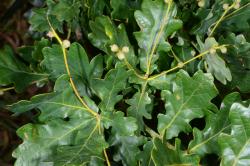- Taxon
- Gallery
Large, widespreading, deciduous tree (to c. 30 m tall in cultivation), with very rough, dark grey, fissured bark. Shoots glabrous, brown or brownish green, lenticellate. Buds usually ciliate, without surrounding stipules. Petiole usually < 2 mm but sometimes to 10 mm long, glabrous. Stipules subulate, soon caducous. Lamina on adult shoots (2)–4.5–18 × (1.5)–3–9 cm, narrowly to broadly obovate, glabrous at maturity or slightly hairy on midrib below, dull above, membranous, ± lyrate-pinnatifid with 3–7 pairs of obtuse teeth or lobes; lower teeth often shallowly crenate; largest lobes at widest part and usually extending ?-1/2 distance to midrib; base cordate or auriculate and almost or entirely concealing petiole. ♂ catkins 3–9 cm long; rachis hairy or nearly glabrous; lower fls distant; perianth 1–1.7 mm long, pilose, often reddish; stamens 3–9. Fruiting peduncles 3–13 cm long, with 1–3 fertile frs; frs reaching maturity in first year. Cup usually 1.5–2 cm diam.; scales ovate, puberulent, appressed or nearly so. Acorn 2–4 cm long, oblong-ellipsoid or oblong-ovoid, 1/4-⅓ enclosed by cup.
[From: Webb et al. (1988) Flora of New Zealand. Volume 4.]
Flowering: Sep.–Oct.




